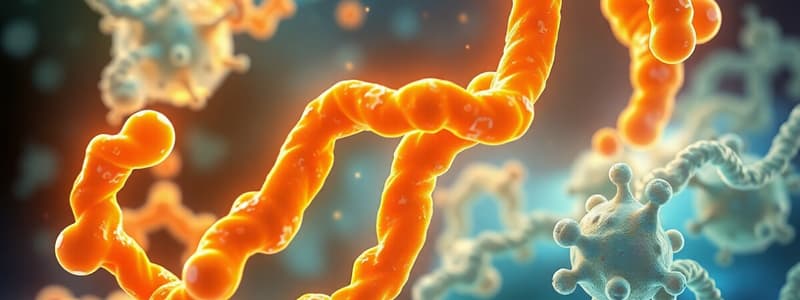Podcast
Questions and Answers
What is the primary difference in structure between RNA and DNA?
What is the primary difference in structure between RNA and DNA?
- RNA is double-stranded, while DNA is single-stranded.
- RNA is a single strand, whereas DNA forms a double helix. (correct)
- RNA contains thymine, while DNA contains uracil.
- RNA consists of deoxyribose sugar, while DNA consists of ribose sugar.
Which nucleotide is found in DNA but not in RNA?
Which nucleotide is found in DNA but not in RNA?
- Thymine (T) (correct)
- Uracil (U)
- Cytosine (C)
- Adenine (A)
What role does transfer RNA (tRNA) play in protein synthesis?
What role does transfer RNA (tRNA) play in protein synthesis?
- tRNA synthesizes the protein chains directly.
- tRNA stores genetic information.
- tRNA reads the mRNA sequence.
- tRNA brings amino acids to the growing peptide chain. (correct)
What happens to ATP when the third phosphate group is cleaved off?
What happens to ATP when the third phosphate group is cleaved off?
What is the process called when a phosphate group is cleaved from ATP?
What is the process called when a phosphate group is cleaved from ATP?
What is the primary function of enzymes in chemical reactions?
What is the primary function of enzymes in chemical reactions?
Which of the following correctly describes a coenzyme?
Which of the following correctly describes a coenzyme?
Which statement best describes exergonic reactions?
Which statement best describes exergonic reactions?
What are glycoproteins primarily composed of?
What are glycoproteins primarily composed of?
Which of the following best describes saturated fatty acids?
Which of the following best describes saturated fatty acids?
What are triglycerides primarily used for in the body?
What are triglycerides primarily used for in the body?
Which structure is characteristic of steroids?
Which structure is characteristic of steroids?
What role does DNA play in relation to proteins?
What role does DNA play in relation to proteins?
Flashcards are hidden until you start studying
Study Notes
Chemical Level of Organization: Enzymes
- Enzymes are proteins that function as catalysts, lowering activation energy required for chemical reactions.
- Enzymes remain unchanged after reactions and significantly speed up reaction rates.
Enzyme Functionality
- Cofactors are ions or molecules that bind to enzymes, necessary for substrate binding.
- Coenzymes are nonprotein organic molecules (often vitamins) assisting enzymes in reactions.
Energy Reactions
- Exergonic reactions release more energy than they consume.
- Endergonic reactions consume more energy than they produce.
Proteins and Combinations
- Glycoproteins combine large proteins with small carbohydrates, functioning in enzyme activity, immune response, hormone regulation, and mucus production.
- Proteoglycans consist of large polysaccharides attached to polypeptides, enhancing viscosity and forming essential connective tissue.
Lipids Overview
- Lipids are predominantly hydrophobic molecules, including fats, oils, and waxes, composed mainly of carbon and hydrogen atoms.
Classes of Lipids
- The main classes include fatty acids, eicosanoids, glycerides, steroids, phospholipids, and glycolipids.
Fatty Acids
- Fatty acids are categorized as:
- Saturated: Fully hydrogenated, with no double bonds.
- Unsaturated: Contains one or more double bonds.
Eicosanoids
- Derived from arachidonic acid, eicosanoids act as hormones influencing various physiological processes.
Triglycerides
- Triglycerides consist of a three-carbon glycerol backbone linked to three fatty-acid tails, serving as fat storage, with high levels associated with cardiovascular issues.
Steroids
- Steroids are characterized by four fused carbon rings and play various roles in cell signaling and membrane fluidity.
Nucleic Acids
- Large organic molecules like DNA and RNA, nucleic acids manage genetic information and protein synthesis at the molecular level.
DNA and Protein Synthesis
- DNA encodes the instructions for protein construction within the cell nucleus.
RNA Structure
- RNA is a single-stranded nucleic acid, while DNA forms a double helix with complementary base pairing through hydrogen bonds.
Nucleotides
- Nucleotides are the building blocks of nucleic acids, composed of:
- A sugar (deoxyribose in DNA)
- A phosphate group
- A nitrogenous base (A, G, T, C)
Nitrogenous Bases
- DNA features bases adenine (A), thymine (T), cytosine (C), and guanine (G).
- In RNA, uracil (U) replaces thymine (T).
Functions of DNA
- DNA determines inherited traits, directs protein synthesis, controls enzyme production, and regulates metabolism.
RNA Functions
- RNA plays multiple roles in protein synthesis:
- mRNA: Carries genetic information from DNA to ribosomes for protein synthesis.
- rRNA: Assists in reading the mRNA and maintaining structure.
- tRNA: Transfers the correct amino acids during protein assembly.
ATP and ADP: The Body’s Energy Molecules
- ATP (Adenosine Triphosphate): Contains three phosphate groups; energy is released when the third phosphate is detached, converting ATP to ADP.
- ADP (Adenosine Diphosphate): Consists of two phosphate groups.
Dephosphorylation Process
- Dephosphorylation involves removing a phosphate group from ATP, resulting in ADP and inorganic phosphate (Pi), releasing energy for cellular processes.
Studying That Suits You
Use AI to generate personalized quizzes and flashcards to suit your learning preferences.





